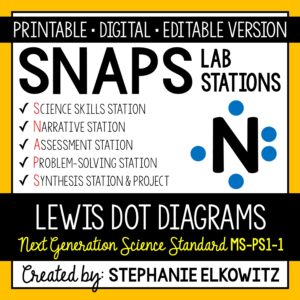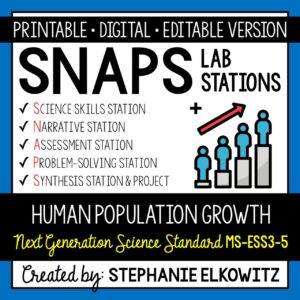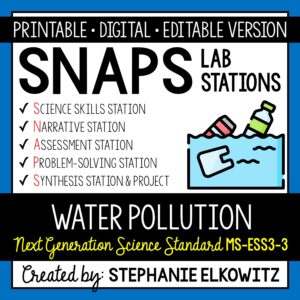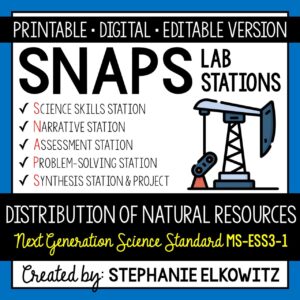Combustion Lab
$7.00
An engaging lab activity designed to enhance students’ understanding of combustion and the impact of the internal combustion engine.
Description
SNAPs Lab Stations Activities require students to use science, math, literacy, problem-solving and engineering skills. They are designed to enhance students’ understanding of scientific concepts and help students apply scientific ideas to the real world. Each station activity promotes skills so to develop students into proficient and competent scientific thinkers.
SNAPs lab activities have five components:
• Science Skills Station to develop science skill proficiency
• Narrative Station to build science literacy
• Assessment Station to evaluate learning and understanding
• Problem-Solving Station to foster engineering design
• Synthesis Station and Project to inspire higher-order learning
DIGITAL LABORATORY – DISTANCE LEARNING & DIGITAL CLASSROOMS
• This lab is offered in a digital format to support digital classrooms & distance learning.
• The digital lab activity is designed to work with Google Slides and Microsoft PowerPoint
• The digital lab activity CANNOT be edited. However:
– Students can manipulate text boxes
– Students can create tables, graphs and diagrams
– Students can insert images and drawings
GOOGLE FORM ASSESSMENT STATION
• The assessment station is offered as a self-grading Google Form.
• Questions are all short answer and are 100% editable.
• Suggestions for use are included in the download.
DISTANCE LEARNING COMPATIBILITY
SNAPs lab activities are rated for their ease with distance – independent learning. Refer to the preview for more information about how well this laboratory works in a fully digital classroom and with distance learning.
EDITABLE DOCUMENTS
This download includes an editable word document (docx file) of all lab components:
• Pre-Lab and Post-Lab Activities
• The Lab Overview
• Lab Station Activities and Questions
• Directed Synthesis Project (when applicable)
Important Notes:
• Diagrams, illustrations, tables and graphs essential to lab activities are included
• Illustrative clipart is NOT included
• Editable documents and rubrics are included with the FREE SNAPs Setup Guide
Editable files allow you to:
• Edit the scope of the activities so to suit your students’ needs
• Edit the materials required based on resource availability
• Create single-period “mini-labs” using activities at the individual skills stations
The activities at each station in this lab are detailed below.
Combustion Stations Activity Learning Objectives
1. Explain what happens during combustion.
2. Make observations to identify the reactants and products of combustion.
3. Graph data to compare and contrast the heat of combustion of common fuels.
4. Analyze data so to evaluate the environmental impact of common fuels.
5. Compare and contrast complete and incomplete combustion.
6. Discuss the development and applications of the internal combustion engine.
7. Assess the affordability, efficiency and sustainability of different fuels used by cars.
Science Skills Station
Students will perform a demonstration to observe combustion and understand how oxygen plays a role in the reaction. Students will also complete a graphing activity so to compare the energy released during the combustion of common fuels. Students can practice writing balanced equations for the combustion of common fuels.
Narrative Station
Students will read an informative text about combustion. Students will also watch a video about fire and combustion. An optional video about complete and incomplete combustion is included.
Assessment Station
At this station, students will answer questions about key terms and ideas relating to combustion. Students must employ lower, mid and higher order thinking skills to answer these questions.
Problem-Solving Station
Students will learn about the internal combustion engine at this station. They will study how the engineering design process was applied to the development of the engine. Then students will assess the affordability, efficiency and sustainability of different fuels and form arguments as to what fuel(s) we should use for personal travel.
Synthesis Station
Students will compose a CER (claim-evidence-reasoning) report to summarize the lab. Students are provided the claim statement and must support the claim with observations, data and other information gathered in the lab. Students will explain how the evidence supports the claim using scientific reasoning.
Synthesis Project
Students will have a choice of 11 projects. Refer to the SNAPs Lab Stations Best Practices and Setup Guide for directions and suggestions on how to conduct the project.
This download includes:
• A pre-lab assignment and post-lab reflection
• Directions and questions for each lab station
• Student recording sheets
• Teacher Key
Additional Materials Required:
3 Computers or tablets
Birthday candle (one per group)
Playdoh (or similar material)
Small glass beaker or similar jar (tall enough to cover a burning birthday candle)
Large glass beaker or jar
Matches or lighter
NEXT GENERATION SCIENCE STANDARDS
This laboratory does not address a specific Next Generation Science Standard, but it complements NGSS concepts. It combines the three dimensions of science learning – science and engineering practices, disciplinary core ideas and crosscutting concepts – in order to meet the standard. This laboratory also makes interdisciplinary connections to STEM, Math CCSS and ELA CCSS to build the appropriate skills.
TERMS OF USE
• All rights reserved by Stephanie Elkowitz.
• This product is to be used by the original purchaser only.
• Intended for classroom and personal use only.
• Copying for more than one teacher, classroom, department, school, or school system is prohibited.
• This product may not be distributed or displayed digitally for public view.
• Failure to comply is a copyright infringement and a violation of the Digital Millennium Copyright Act (DMCA).









